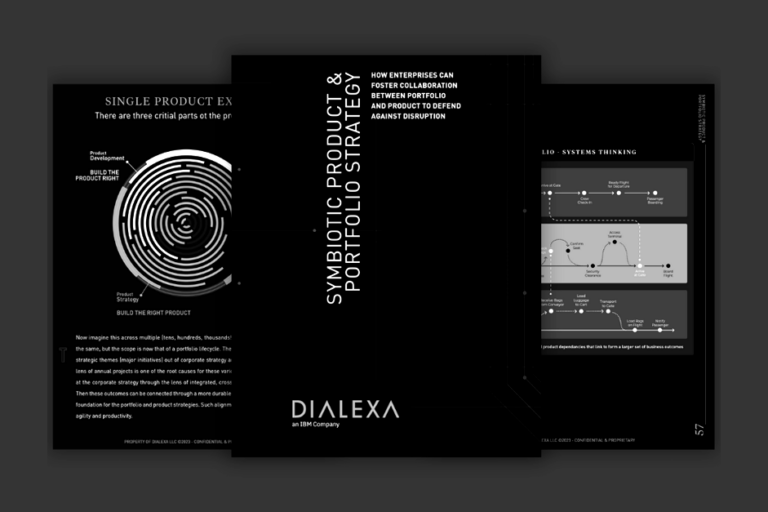Every business will need to go through a transformation in order to survive the ever-changing landscape of technology.
If you do not believe us, ask Blockbuster, Kodak, Tower Records, Borders, Toys R Us, Pan Am, and Compaq. No company is immune to becoming obsolete. If you combine this with the commonly referenced statistic that 70%¹ of innovation projects will fail, one has to wonder what is that secret sauce that separates the ordinary performers from the extraordinary winners in their category.
The most common challenges companies face today when building digital products are building products that do not meet the customer needs, or a product that fails to perform, scaling challenges, and lack of speed to value. To increase the success of products in the marketplace, it is not only necessary to know the right product to build, but you must be able to build the product right and enable the right operating elements to help make the product successful.
Oftentimes, when a company thinks of undergoing a transformation, they will spend millions of dollars to train their employees on becoming more agile, even adopting specific frameworks like SAFe (a common approach to scaling agile practices), Scrum, Extreme Programming (XP) and Kanban. The ultimate goal of these software development frameworks is to break down traditional silos and foster a collaborative team environment that business needs and customer demands. Yet many companies that adopt agile practices struggle to build, maintain and operate successful products.
Agile Transformation and Enterprise Product Transformation are two distinct concepts that are often confused or used interchangeably in the business world– they are not the same.
Agile transformation is a process of adopting an agile approach in an organization. The goal of an agile transformation is to make the organization more flexible and responsive to change by breaking down work into smaller chunks and creating a more iterative process. This is based on the Agile Manifesto, which values individuals and interactions, working software, customer collaboration, and responding to change. Agile transformation can involve changes in culture, processes, and mindset, with a focus on transparency, collaboration, and continuous improvement. An agile transformation may also include the adoption of tools and technologies to support agile practices such as scrum, Kanban, or lean development. The primary shortcoming of nearly all agile transformations is that, even when executed well, all too often they become only focused on delivery productivity only rather than on delivering true business outcomes.
Product transformation, on the other hand, helps companies drive alignment between the goals of the business and the technology capabilities to get you there. This involves identifying and implementing changes to a company’s organization and how they build products to better meet the needs of customers and keep pace with evolving market trends. One key aspect of this process is optimizing investments and accelerating value creation. By working with clients to identify enterprise portfolio opportunities, we help companies allocate resources more effectively and prioritize investments in areas that will drive the greatest value for the business. This may involve divesting from products or services that are no longer aligned with the company’s goals, or investing in new areas where there is untapped potential. By applying organizational standards, we can help ensure that new products and services are developed in a consistent and efficient manner, accelerating the speed at which value is created.
Another important aspect of product transformation is identifying gaps and synergies across digital products, platforms, and teams. We like to help companies better understand the relationships between different products and capabilities to identify areas where they can work together to create greater value. This may involve integrating products that were previously siloed, or developing new products that build on the strengths of existing offerings. By defining the architecture to accelerate scalable, secure delivery, we can help companies develop a more flexible and responsive infrastructure that can support these changes. Once this operating model is established, we can help companies scale how digital products are built across the entire company, ensuring that new products are developed in a consistent and efficient manner, and that they align with the company’s overall goals and strategy.
The value of getting the foundation right is that once a company adopts a product-minded operating model, it can transform an organization’s business model, operations, and customer experience. This involves leveraging data, analytics, cloud computing, artificial intelligence, and other digital technologies to create new business models, products, and services that meet changing customer needs and expectations.
We will discuss 5 key principles we use to drive product transformation in enterprises.
- Empower both leadership and employees to create a culture of innovation that focuses on building successful products,
- Collaborative approach to designing, building and launching the right products,
- Utilize the right data to inform, prioritize and make decisions quickly,
- Balance the needs of the customers and the business to drive successful outcomes,
- Fundamentally change in the way an organization operates by adopting operating, economic, organization and delivery models that are in balance with one another.
Empowering team to create a product mindset
The culture of innovation in an organization is heavily influenced by the way it is structured. Organizations that prioritize innovation tend to have a more entrepreneurial culture, emphasizing experimentation and risk-taking. On the other hand, more bureaucratic or hierarchical organizations can have a culture that is less conducive to innovation, stifling creativity. Therefore, empowering people and instilling a product approach that balances the customer’s needs with the needs of the business is crucial for driving innovation and building successful products.
A product mindset involves continuous experimentation and learning, and organizations must create a safe environment for experimentation and failure to empower people. Encouraging curiosity, trying new things, and learning from mistakes helps develop a product mindset that focuses on building great products that drive business outcomes. Clear product goals aligned with the organization’s vision and mission help people understand what they are working towards and how their work impacts the product’s success. Prioritizing and building products that deliver value to the customers and the business is the key to success.
Empowering people also requires providing the necessary resources and support to help them build successful products, including access to training and development opportunities, tools, technologies, and mentorship and coaching. It enables people to develop the skills and knowledge they need to build products that meet customer needs. In conclusion, a culture of innovation depends on empowering people and instilling a product approach that emphasizes experimentation, learning, clear goals, and support, enabling them to balance customer needs with business outcomes.

Creating a collaborative and cross-functional approach to problem solving.
In today’s fast-paced business world, it’s important to have cross-functional teams that work collaboratively across departments. This means breaking down traditional silos and creating network-embedded teams that bring together diverse perspectives and skill sets. The role of the Product Manager is to bring it all together, taking a holistic approach to product development that considers the needs of all stakeholders.
At Dialexa, Collaborative Quality™ (“CQ”) is not just about code, it’s about aligning product strategy and development teams to the highest priority value of the product. This means making CQ a part of the product development process from the very beginning, not just at the end. By involving all stakeholders in the quality process, from product strategists to development teams, you can ensure that quality is built into the product from the ground up. Testing is a critical part of the product development process, but it shouldn’t be an afterthought either. Instead, it should be integrated into the product development process from the beginning. By identifying how you will test a product as you are capturing requirements, you can ensure that your product meets customer needs and is of high quality.
Collaboration among team members is also crucial for creating products that effectively meet customer needs. To achieve this, it’s essential to take a holistic approach that considers the business context such as the market and competitive landscape. By working together to analyze market expectations, existing designs, and competitive offerings, team members can identify opportunities for making the product successful that might not be apparent from a singular perspective. By framing these opportunities early on in the strategy and design process, the team can ensure that the final product effectively addresses customer needs, meets business outcomes and stands out in the marketplace. The success of the product ultimately depends on the team’s ability to work collaboratively, drawing on each member’s expertise and experience to create a solution that truly meets customer needs and business goals.
Using data to inform product roadmaps, prioritize features and measure success
We believe that data plays a critical role in informing product roadmaps. By analyzing customer behavior and feedback, product managers and development teams can gain valuable insights into what features and functionalities are most important to their target audience. At Dialexa, we do this through Product Performance-related activities such as implementing and analyzing product analytics. Teams can also identify pain points and areas for improvement that can inform future product development. Additionally, data on product usage, adoption, and retention can help product managers assess the effectiveness of existing features and make informed decisions about what to prioritize in future releases. By leveraging data in this way, product managers can develop a more data-inspired product roadmap that is aligned with the needs of their customers and the goals of the business.
However, balancing the needs of the customer with the goals of the business can be a challenging task for product managers and product teams. On one hand, it’s important to prioritize features and functionalities that will provide the greatest value to customers and improve their overall experience with the product. On the other hand, product managers need to consider the financial implications of their decisions and ensure that the product aligns with the broader goals and strategy of the company. This is where Value Orchestration at Dialexa can be particularly helpful. By tracking key metrics such as revenue, user engagement, and conversion rates, product managers can assess the impact of their decisions on the business and make data-driven decisions about where to focus their efforts. Ultimately, striking the right balance between customer needs and business goals is critical for creating a successful product that delivers value to both customers and the company.
Balancing the needs of the business and customers in order to shape the right solution
Knowing how to balance the needs of the business and customers is more of an art than a science when building the right product. However, achieving this balance can be difficult to handle uncertainty and complexity. To address this, one needs to adopt a product mindset and think of the product as a standalone business with its own profit and loss, team, skills, and governance structure. By understanding interdependencies with other technologies, data, teams, and processes, the product/portfolio can be aligned with the corporate/enterprise strategy.
Product strategy is a crucial aspect of building products that help businesses to balance the needs of the business, the market, and the customer. By aligning the product strategy with the overall business strategy and understanding the market and customer needs, companies can create products that not only generate revenue and growth but also address the problems and pain points of their customers. A well-defined product strategy also helps businesses to stay ahead of the competition by anticipating future trends and emerging technologies that will impact the market and customer needs. At Dialexa, a Product Strategy engagement is the key to balancing the needs of the business, the market, and the customer and creating successful products that drive business growth and customer satisfaction.
As part of our Product Strategy approach, we can also develop prototypes or a proof of concept to help executives learn before building a product. We can also use this approach to test customer sentiment or gather more information from target users. This helps us determine quick wins that meet both the criteria for the customer as well as the business needs.
Transforming how the organization works
Transforming a business can be a complex process that involves making significant changes to the organization’s technology, processes, and culture. As such, many organizations experience tensions when deciding how to approach a transformation. One key tension is financial in nature as it can require significant investments in technology, personnel, and training. Organizations may be hesitant to make these investments, particularly if they are unsure of the return on investment or if they are facing financial constraints. Balancing the cost of a transformation against the potential benefits can be a difficult decision and one that requires careful consideration of the organization’s goals and priorities. One way to achieve this is through portfolio rationalization, which involves evaluating and optimizing an organization’s product portfolio to ensure that it aligns with the organization’s overall strategy and financial objectives.
Operational tensions can also arise when making decisions about a transformation. Introducing new technology and processes can disrupt existing workflows and require employees to learn new skills. This can cause resistance and pushback from employees who are comfortable with the status quo. Additionally, implementing new technology can introduce new risks, such as cybersecurity threats or system failures. Organizations must balance the potential benefits of a transformation against these operational challenges and ensure that they have plans in place to mitigate any risks that may arise.
We help executives shift their thinking from traditional IT-centric approaches to a focus on delivering customer value through products. This can be achieved through app modernization, which involves redesigning and updating legacy systems to take advantage of new technologies and business models. However, this process must also take into account the organizational implications, including changes to the organization’s culture, processes, and governance structures.
Lastly, functional tensions can arise when different departments and stakeholders may have competing priorities or conflicting views on how best to approach changing how they do things. Balancing these competing priorities and ensuring that all stakeholders are aligned around a common vision can be a significant challenge. Effective communication, collaboration, and leadership are essential for overcoming these functional tensions and ensuring that the organization can successfully transform and remain competitive in the digital age.
At Dialexa, we take a capability-driven approach identifying and prioritizing the capabilities required to deliver customer value through products. This involves mapping the organization’s existing capabilities against the desired product outcomes and identifying any gaps that need to be addressed. By doing so, more traditional IT organizations can better understand how to allocate resources and prioritize initiatives to support products and provide customer value. Additionally, we can help organizations identify areas where new capabilities need to be developed or existing ones enhanced, as well as areas where capabilities may need to be retired or outsourced. Dialexa can help existing teams accelerate speed to market by filling in for capabilities companies need to develop.
In conclusion, companies will need to undergo a transformation to stay relevant in the ever-changing technology landscape. This transformation goes beyond digital transformation as the challenges faced by companies when building digital products are now mostly organizational in nature. Our product approach, which can be used in conjunction with other frameworks like SAFe agile, helps drive alignment between business goals and technology capabilities by identifying and implementing changes to a company’s organization and how they build products.
¹Source: “70% of Product Initiatives Fail? Let’s See the Evidence” by Nacho Bassino
ABOUT THE AUTHORS

Jeanette Cajide is a Senior strategy and operations executive with experience leading teams to create, launch and scale new ventures. Prior to Dialexa, she worked at Goldman Sachs, Accenture, and Merrill Lynch and has launched several technology startups. She has an MBA from Northwestern, an MPA from Harvard, and a Bachelors from The University of Texas at Austin.
Connect with Jeanette on LinkedIn

Stephanie Payne is a Principal, Product Strategist, Stephanie guides our clients to build and enhance products that scale. She began her career in marketing and quickly grew into developing innovative digital product experiences to support enterprises and venture-backed startups. Now, Stephanie is helping enterprises scale product strategies by operating in the space between portfolio and product to support digital transformation efforts. She has worked in the industry for 10+ years developing and designing digital products for Fortune 500 clients.
Connect with Stephanie on LinkedIn






